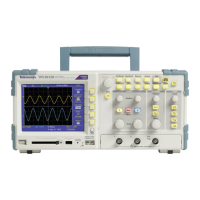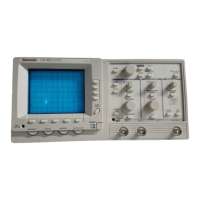Reference
Options Settings Comments
Edge With Edge high
lighted, the rising or
falling edge of the input signal is used
for the trigger
Source Channel 1, 2, 3
1
,or4
1
,Ext,
Ext/5, Ext/1
0
Select the input source as the trigger
signal (See p
age 114.)
Slope
Rising, Falling
Select to tr
igger on either the rising
or falling edge of the signal
Mode Auto, Norma
l
Select the type of triggering (See
page 113.)
Coupling AC, DC, Noise Reject, H F
Reject, L
F Reject
Selects the components of the trigger
signal ap
plied to the trigger circuitry
(See page 114.)
1
Available only on a 4-channel oscilloscope.
Trigger F
requency Readout
The oscilloscope counts the rate at which t riggerable events occur to determine
trigger frequency and displays the frequency in the lower right corner of the
screen.
NOTE. T
he trigger frequency readout shows the frequency of events the
oscilloscope might consider to be a trigger, and may be less than the frequency of
the input signal in Pulse Width trigger mode.
Key Po ints
Mode Options. The Auto mode (default) forces the oscilloscope to trigger when it
doe
s not detect a trigger within a certain amount of time based on the horizontal
scale setting. You can use this mode in many situations, such as to monitor the
level of a power supply output.
Use the Auto mode to let the acquisition free-run in the absence of a valid trigger.
This mode allows an untriggered, scanning waveform at 100 ms/div or slower
time base settings.
The Normal mode updates displayed waveforms only when the oscilloscope
detects a valid trigger condition. The oscilloscope displays older waveforms until
the oscilloscope replaces them with new ones.
Use the Normal mode when you want to see only valid triggered waveforms.
When you use this mode, the oscilloscope does not display a waveform until
after the first trigger.
To perform a Single Sequence acquisition, push the Single button.
TPS2000B Series Digital Oscilloscope User Manual 113

